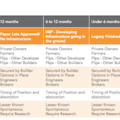Every builder knows that land and lot positions are a double-edged sword. If you have too large of a land-and-lot pipeline, you can crush your results even if you are selling per plan. If you are short on lots, your overhead can eat you alive. Right now the challenge is to replenish your lots in such a way that your upside is good, but your exposure is not too large. Disruptive events can happen and even though we are in a promising time, those moments that give you pause can throw your financials into a tailspin. We need to balance risk and reward.
Recently, many clients are concerned that their lot positions are too low to fulfill demand. Many times they are locked into thinking the only source of lots comes from their own effort and perseverance. But as shown in the Land and Lot Pipeline Table below, there may be various opportunities that builders and developers do not consider. There is one thing for sure, and that is in every market where I work, everyone says there are not enough lots. And in almost every instance, when we did further research and reached out to others in the industry, we were able to secure the needed lots.
For example, a client in a Northeast market did not have enough build-ready lots in the pipeline, and the company’s overhead either had to be reduced or we needed to get more throughput (delivery of homes in the current fiscal year). We searched out some opportunities that were available through banks and with other builders who had some scattered lots that were geographically manageable (the 45-minute rule), and our builder’s position improved.
In another situation, a builder needed more lots at the same time a deal structure fell apart due to funding issues with another company’s partners. In this case, the client secured lots because he was in the right place at the right time. The fluidity of the land and lot market always is beneficial to the builders who remain diligent and in constant contact with all the purveyors of finished lots, such as land owners, engineers, public officials, and other builders and developers.
Bank loan requirements and 2014 metrics require more conservatism and fragmentation of risk. Sometimes bankers may suggest other builders who could benefit from a large land or lot position, and sometimes deal structures change quickly due to other holdings that had an unforeseen or unfortunate event. If you or someone on your team is constantly involved in conversation with a variety of decision-makers, there is a great chance you may benefit from one of these disruptions that are a part of the economic uncertainty in our industry. The pipeline table reflects myriad ways in which opportunities may develop within the process of bringing finished lots to market.
Given the discussion above, I would argue there really are plenty of lots. First, consider the natural lot pipeline, the nature of which takes a fair amount of time to move from raw land to a finished lot. Many activities and transactions, as well as the timing of those events, do not always align with the goals of the people and organizations who own those lots. There are, then, many occasions when they might wish to offload some land, lots, or both. So if a builder has a large tax payment, for example, and wants to convert some lots to cash, you might be able to help out.
Our industry is competitive, but many win-win conditions exist that help to equalize and balance lot holdings and land positions. Throw in your bid or make a call. You might be surprised that a large developer would welcome a 10-lot takedown in quick order.
Due to the large and significant disjunction of the land and lot pipeline, there are many builders and developers now sitting on inventories that are too large to absorb fast enough. In some markets they do not have the financing to improve the approved lots they hold. This is another case where opportunities exist for partnerships that are unique and varied.
Yet another opportunity comes from utility contractors and the absence of depth in many markets. A large number of utility contractors went out of business during the recession. As a result, we have improvement costs that are not sustainable or market competitive. This correction is sowing chaos and confusion, but we can work together to fill voids in the delivery of land and lots. Ultimately the consumers want houses, but we will need to be creative to make them happen in a timely and cost-effective way.
In current conditions, builders are running out of lots too quickly (e.g., only 18 months’ worth left) and must back into the pipeline to find other sources that may have too many lots at that stage and would like to sell or partner on that position. Do not think only of finished lots that can be delivered in 30 days or less; expand your reach into the pipeline to protect your projected deliverables.
The land and lot inventory supply is not static; it is an ever-changing condition. You should not despair, however. One week Developer A is indifferent toward your offer, yet the next week they find out they are short on cash due to a capital call on another position. The best builders are always shaking the trees to find some fruit all year long.
Another overlooked area is with scattered lot positions and partnerships with silent partners. Often times people and entities own land and lots and have no idea how to monetize them. It is your lucky day when you track down some folks who genuinely need your expertise and abilities to transform a stagnant land position to one that generates revenue.
I continue to be positive on the availability of lots in every market because I witness over and over again the creativity and ability of the free market to adapt and address supply and demand issues. Sometimes the deal flow is harder to create than others, but tenacity and timing in many instances will make the difference. Keeping on top of these situations requires someone to be accountable and responsible for results. If you do not have such a person on your team, then perhaps the problem is dedicated leadership and not the actual marketplace conditions.
Many of us know that many regional builders went into Chapter 11 because they were long on land. Some builders have learned from that experience and with them lies the opportunity for partnerships and a well-thought-out product offering. Despite the saying of the ‘80s, greed is not good when it comes to holding too much land. The current aversion to risk is there for good reasons. This means smaller and more fragmented holdings tend to populate the marketplace. Given the sluggish fall and delayed selling-season start of 2014, plenty of builders have the jitters. This creates a setting for some to offload large land positions and make their holdings more palatable for risk adverse investors.
If I average 100 home sales per year but I hold 500 lots, would I sell a few? Possibly. Many other builders are simply tired of the risk and potential body-slam if they remain long on land. Find those people in your marketplace. You do not need to be best friends, just industry professionals helping each other get your timing and inventory levels right. Another factor in this equation is that many developers are still having difficulty securing improvement loans; your purchase may help the entire development deal occur. I like to see my clients with a pipeline that can fulfill demand for two to three years. If your pipeline is larger than that (or you know someone in that position), it is time to offload some of it and bring land risk and deliveries in line. Keep in mind, scaling your company to a larger size is another option to ensure that your lot absorptions are in equilibrium.
My intention with this article is to encourage all participants in the land and lot marketplace to think creatively and to think outside of their normal sources of land and lots. I have worked with builders and developers since 1991, and I am amazed that often it is only when my clients get pushed that they get more and more creative and undertake some of the action items I suggested. When they do, they end up with winning solutions.
I would like to leave you with a final thought. There will always be more opportunities than you think because the following events will occur: the timing of ownership is not right, financing is not available, the lives of the land owners change in some way, the government changes reporting laws for the public builders, banking regulations change how assets are held, there are unexpected cash demands, companies experience poor development management or timing, and so on. Do not be downhearted. Be aggressive and fearless and seek opportunities in all the nooks and crannies of your marketplace. You will be rewarded. PB
Noelle Tarabulski is CEO of Builder Consulting Group in Lakewood, Colo., a management consulting firm dedicated to builders and developers since 1991. She can be reached at noellet@buildertools.com.









